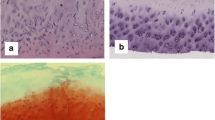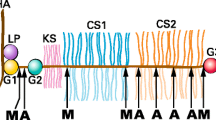Abstract
A well characterized rabbit polyclonal antibody against human carboxy-terminal type II procollagen peptide (pCOL-II-C) was used to study the immunolocalization of pCOL-II-C in articular cartilage obtained from patients with osteoarthritis (OA), rheumatoid arthritis (RA), and control non-diseased joints. In moderately degenerative OA cartilage, immunoreactive chondrocytes were observed in all layers, particularly along the margins of fibrillation and fissures, in chondrocyte clusters and in osteochondrophytes. The grade of immunostaining in OA correlated directly with Mankin's histological-histochemical scores of 0–7, but there was an inverse correlation between grade of immunostaining and Mankin's scores of 8–14. The grade of immunostaining was significantly higher in OA than in RA and normal control cartilage. Since type II collagen is a unique component of articular cartilage, localization of pCOL-II-C could reflect the increased synthesis of type II collagen by chondrocytes in diseased cartilage.
Similar content being viewed by others
References
Aigner T, Stöß H, Weseloh G, et al. Activation of collagen type II expression in osteoarthritic and rheumatoid cartilage. Virchows Arch B Cell Pathol 1992;62:337–45.
Arnett FC, Edworthy SM, Block DA, et al. The American Rheumatism Association 1987 revised criteria for the classification of rheumatoid arthritis. Arthritis Rheum 1988;31:315–24.
Brennan FM, Maini RN, Feldmann M. TNF α—a pivotal role in rheumatoid arthritis? Br J Rheum 1992;31:293–8.
Buckwalter JA, Mow VC, Ratcliffe A. Restoration of injured or degenerated articular cartilage. J Am Acad Orthop Surg 1994;2:192–201.
Cheung HS, Lynch KL, Johnson RP, et al. In vitro synthesis of tissue-specific type II collagen by healing cartilage. Arthritis Rheum 1980;23:211–9.
Choi HU, Tang L-H, Johnson TL, et al. Isolation and characterization of a 35000 molecular weight subunit fetal cartilage matrix protein. J Biol Chem 1983;258:655–61.
Dean DD, Martel-Pelletier J, Pelletier J-P, et al. Evidence for metalloproteinase and metalloproteinase inhibitor imbalance in human osteoarthritic cartilage. J Clin Invest 1989;84:678–85.
Goldwasser M, Astley T, van der Rest M, et al. Analysis of the type of collagen present in osteoarthritic human cartilage. Clin Orthop 1982;167:296–302.
Kowanko IC, Ferrante A. Granulocyte-macrophage colony-stimulating factor augments neutrophil-mediated cartilage degradation and neutrophil adherence. Arthritis Rheum 1991;34:1452–60.
Lotz M, Terkeltaub R, Villiger PM. Cartilage and joint inflammation. Regulation of IL-8 expression by human articular chondrocytes. J Immunol 1992;148:466–73.
Mankin HK, Dorfman H, Lippiello L, et al. Biochemical and metabolic abnormalities in articular cartilage from osteoarthritic human hips. J Bone Joint Surg Am 1971;53:523–37.
Mankin HJ, Brandt KD. Biochemistry and metabolism of articular cartilage in osteoarthritis. In: Moskowitz RW, Howell DS, Goldberg VM, Mankin HJ, editors. Osteoarthritis: Diagnosis and medical/surgical management. Philadelphia: WBSaunders, 1992:109–54.
Mayne R. Cartilage collagens. What is their function, and are they invoked in articular disease? Arthritis Rheum 1989;32:241–6.
Nelson F, Reiner A, Ionescu M, et al. The content of the C-propeptide of type II collagen in articular cartilage is an index of synthesis of this molecule which is increased in osteoarthritis. Proceedings of the 40th Annual Meeting, Orthopaedic Research Society, Feb 21–24 1994, New Orleans, 216. Chicago: Rider Dickerson.
Niyibizi C, Wu J-J, Eyre DR. The carboxypropeptide trimer of type II collagen is a prominent component of immature cartilages and intervertebral-disc tissue. Biochim Biophys Acta 1987;916:493–9.
Okada Y, Takeuchi N, Tomita K, et al. Immunolocalisation of matrix metalloproteinase 3 (stromelysin) in rheumatoid synovioblasts (B cells): Correlation with rheumatoid arthritis. Ann Rheum Dis 1989;48:645–53.
Okada Y, Shinmei M, Tanaka O, et al. Localization of matrix metalloproteinase 3 (stromelysin) in osteoarthritic cartilage and synovium. Lab Invest 1992;66:680–90.
Pelletier JP, Martel-Pelletier J, Malemud CJ. Canine osteoarthritis: Effects of endogenous neutral metalloproteo-glycanases on articular cartilage proteoglycans. J Orthop Res 1988;6:379–88.
Peltonen L, Halila R, Ryhanen L. Enzymes converting procollagens to collagens. J Cell Biochem 1985;28:15–21.
Poole AR, Pidoux I, Reiner A, et al. Association of an extracellular protein (chondrocalcin) with the calcification of cartilage in endochondral bone formation. J Cell Biol 1984;98:54–65.
van der Rest M, Rosenberg LC, Olsen BR, et al. Chondrocalcin is identical with the C-propeptide, of type II procollagen. Biochem J 1986;237:923–5.
Ronziére M-C, Richard-Blum S, Tiollier J, et al. Comparative analysis of collagens solubilized from human foetal, and normal osteoarthritic adult articular cartilage, with emphasis on type VI collagen. Biochim Biophys Acta 1990;1038:222–30.
Ryu J, Treadwell BV, Mankin HJ. Biochemical and metabolic abnormalities in normal and osteoarthritic human articular cartilage. Arthritis Rheum 1984;27:49–57.
Säämänen A-M, Tammi M, Kiviranta I, et al. Levels of chondroitin-6-sulfate and nonaggregating proteoglycans at articular cartilage contact sites in the knees of young dogs subjected to moderate running exercise. Arthritis Rheum 1989;32:1282–92.
Shinmei M, Masuda K, Kikuchi T, et al. Interleukin 1, tumor necrosis factor, and interleukin 6 as mediators of cartilage destruction. Semin Arthritis Rheum 1989;18(Suppl):27–32.
Shinmei M, Inamori Y, Yoshihara Y, et al. The potential of cartilage markers in joint fluid for drug evaluation. In: Kuettner KE, Schleyerbach R, Peyron JG, Hascall VC, editors. Articular cartilage and osteoarthritis. New York: Raven 1992:597–609.
Shinmei M, Ito K, Matsuyama S, et al. Joint fluid carboxyterminal type II procollagen peptide as a marker of cartilage collagen biosynthesis. Osteoarthritis Cartilage 1993;1:121–8.
Tanaka O, Shinmei M, Kikuchi, T, et al. Immunohistochemical study of type II collagen C-propeptide (chondrocalcin) in diseased articular cartilage (in Japanese). J Jpn Orthop Assoc 1989;63(Suppl):S1198.
Uitto J, Allan RE, Polak KL. Conversion of type II procollagen to collagen. Eur J Biochem 1979;99:97–103.
van Beuningen HM, Arntz OJ, van den Berg WB. In vivo effects of interleukin-1 on articular cartilage. Arthritis Rheum 1991;34:606–15.
Yaron I, Meyer FA, Dayer J-M, et al. Some recombinant human cytokines stimulate glycosaminoglycan synthesis in human synovial fibroblast cultures and inhibit in human articular cartilage cultures. Arthritis Rheum 1989;32:173–80.
Author information
Authors and Affiliations
About this article
Cite this article
Nakajima, H., Shinmei, M., Ito, K. et al. Localization of carboxy-terminal type II procollagen peptide (pCOL-II-C) in diseased cartilage. J Orthop Sci 2, 229–238 (1997). https://doi.org/10.1007/BF02489043
Received:
Accepted:
Issue Date:
DOI: https://doi.org/10.1007/BF02489043




